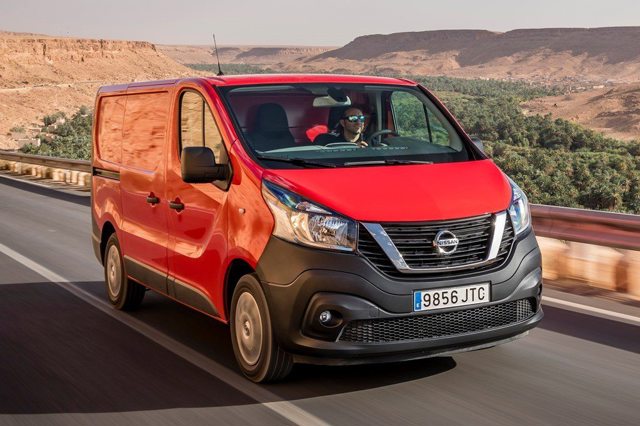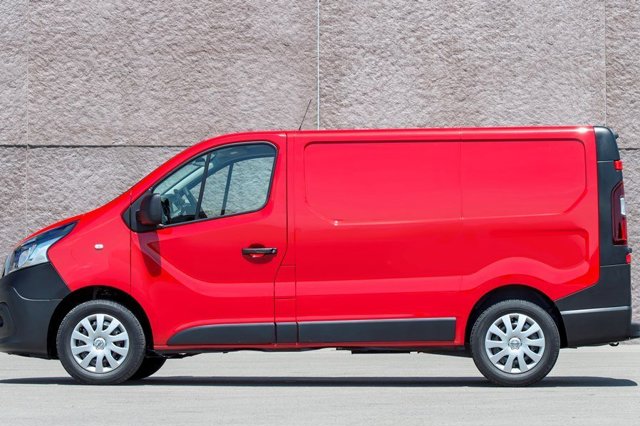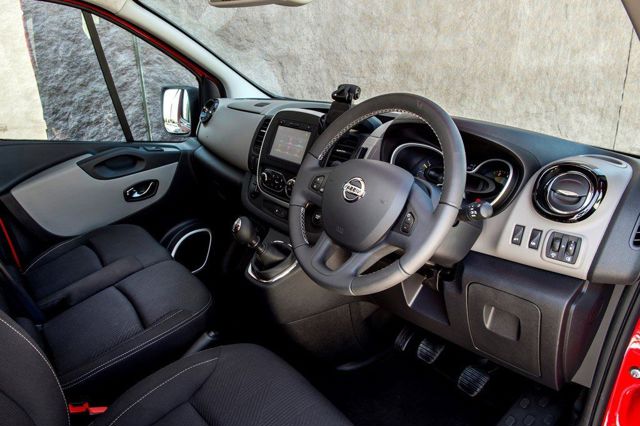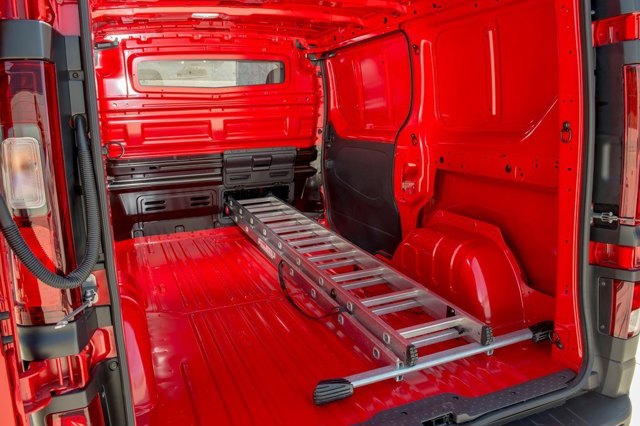Nissan NV300 (2016 – 2021) Review
Nissan NV300 (2016 – 2021) At A Glance
The Nissan NV300 is the sister van to the impressive Renault Trafic. Like its French counterpart, it majors on everyday comfort and practicality. However, unlike Renault, Nissan backs its medium-sized panel van with a comprehensive five-year 100,000 mile warranty as standard.
Available in two load lengths and two heights, the NV300 will easily carry three Euro pallets or up to 10 plasterboard sheets of 2.5 metres, while a bulkhead hatch - standard on Acenta and Tekna trims - will extend the load length to accommodate a couple of ladders or large planks of wood.
With maximum payloads ranging from 1073g to 1310kg and gross vehicle weights spanning from 2.7 to 2.9 tonnes, the NV300 is hugely capable when it comes to moving considerable loads.
The single sliding door provides a wide loading space that measures almost a metre in width, while the rear doors open to 180 degrees and lock for simple loading and unloading. The NV300 can also be fitted with a tow bar and pull up to 2.0 tonnes, when hooked to a braked trailer.
The NV300 is powered by a Renault-sourced 1.6-litre dCi engine, available with 95PS, 120PS, 125PS and 145PS - the two former are single turbo, while the latter pair use a twin-turbocharger. All are linked to a six-speed manual gearbox (there's no auto option) and all of the engines use AdBlue. Claimed economy ranges from 43 to 47mpg.
In 2020 a 2.0 dCi engine was added to the NV300 line-up, with 120PS, 145PS or 170PS. A dual clutch automatic gearbox was also added, while the 1.6 dCi was scaled back to a sole 95PS version.
All versions of the NV300 are easy to drive, with nicely weighted steering and a comfortable, car-like, driving position. The ride is excellent and this, combined with the low levels of exterior noise, makes it easy to drive the NV300 for long periods without feeling tired.
Like many modern vans, the interior has a number of features that allow the driver to transform the cab into a mobile office. There's an optional laptop table, clipboard and mounting points for a smartphone and tablet computer. All NV300s get three seats up front, although legroom in the middle seat is a little restricted due to the position of the gearbox, which might make it a tight fit for a trio of large adults.
If the truth be told, the NV300 is not very much different to the Trafic and older Vauxhall Vivaro in the metal. It uses the same body and engines. The interior is almost identical too, bar some slight changes in trim. However, the Nissan is backed by a longer warranty, which makes it much more appealing when it comes to long term running costs.
Driving the Nissan NV300 (2016 – 2021)
Easy to drive and comfortable, the NV300 handles more like a large car than a van. Road and engine noise levels are well-suppressed, while the nicely weighted steering makes the Nissan a rewarding drive on a twisty A or B road. The supple ride also makes it a good motorway van, with the refined body control and low noise levels cutting driver fatigue over a long journey.
The NV300’s high driving position and large door mirrors make it an easy van to park and drive around town. The comfortable driver's seat has lots of height and lumber adjustment while there's a central armrest, fitted as standard.
The Renault-sourced 1.6 dCi diesel engine is extremely strong and comes with single or twin-turbocharging. The latter providing the best balance between economy and performance. The single-turbo units - with 95PS or 120PS - are not particularly bad, but they can feel a little breathless when it comes to long distance driving with a full load.
The twin-turbo engines - with 125PS or 145PS - provide a much better acceleration, without punishing you at the fuel pumps. Officially, both will exceed 46mpg, while the higher torque levels - a respective 320Nm or 340NM from 1500rpm - makes them ideal for motorway work, with the van happy to sit in a higher gear for longer.
All of the engines are linked to a six-speed manual gearbox - there are no automatic options - while hill start assist is fitted as standard across the range. This should help improve clutch life when it comes to pulling away on a steep incline.
In 2020 Nissan revised the NV300 model line-up by adding a Renault-sourced 2.0-litre diesel. The four-cylinder unit produces 120PS, 145PS or 170PS and meets the Euro6d-TEMP emissions standards. Fans of the old 1.6 dCi engine can still order it with the updated NV300, but it's limited to 95PS only.
Tech levels are sparse on the entry-level Visia trim, but Acenta models do get rear parking sensors, a smartphone dock and a foldable middle seat along with a fixed table backrest, A4 clipboard and under seat storage for a hard hat or work bag. The range topping Tekna trim adds a seven-inch colour touchscreen, navigation and cruise control to the van, along with automatic headlights and windscreen wipers.
Grip control, with settings for mud, snow or sand, is available as a paid-for option, along with an anti-rollover system that automatically applies the brakes to one or more wheels if it detects a potential hazardous situation. A reversing camera - with a display in the rear view mirror - is also available as a factory-fit option.
Nissan NV300 (2016 – 2021) interior
The load area of the NV300 is identical to that of the Renault Trafic, which means even the smallest L1 version is capable of carrying three Euro pallets. All get a full height steel bulkhead as standard, along with a nearside sliding door and pair of unglazed rear doors that open 180 degrees and lock in place for easy loading and unloading.
An additional side sliding door is available as a factory fit option, while Acenta and Tekna models get a load hatch at the bottom of the bulkhead. This allows ladders, metal poles and planks of wood to be loaded. For builders, this hatch will be a must have, owing to the fact that it increases the load length of the van to 3.75 metres (L1) and 4.15 metres (L2).
Both the side and rear doors provide wide loading areas, which makes it simple to load the NV300 up in the shortest amount of time. Nissan offers a range of factory-fit options to improve the van's practicality too, with protective wood trim for the sidewalls, LED lighting and up to 18 interior hooks for securing loads. A tow bar, with electric hook up is also available, allowing the NV300 to tow up to 2.0 tonnes.
Maximum payloads range from 1073g to 1310kg, while the gross vehicle weights span from 2.7 to 2.9 tonnes, depending on which roof height and load length you choose. In its largest form (L2, H2) the NV300 will provide an impressive load volume of 8.6m3, while the smallest provides 5.2m3.
The cabin is one of the best of any panel van on sale today, with three seats and lots of all-round comfort. Admittedly, the middle seat is a little cramped, owing to the position of the gear stick, but only the largest of passengers will find this to be a problem. The driver's seat is well supported and comfortable, with lots of adjustment and padding across the upper leg and lower back.
Cabin storage is plentiful too, with deep door pockets and a pair of large gloveboxes. There is no shortage of cup holders either and there are also useful hooks for hanging work clothes and jackets.
If you find that your van doubles up as a mobile office half the time, then the NV300 in Acenta trim will be suitable. The middle seat folds down to provide a laptop table, while a smartphone dock and A4 clipboard is also included. The middle seat also lifts up to provide storage for a hard hat, workwear or hiding valuables away.
Model History
- September 2016: NV300 launched
- November 2016: NV300 prices announced
- November 2019: Nissan upgrades NV300 with improvements to comfort, safety and style alongside lower emissions
September 2016
NV300 launched
The NV300 is available as a panel van, crew van and as a Combi passenger vehicle. In addition, a floor cab version is available as a rolling chassis and is the perfect platform for bespoke conversions.
The NV300 is backed by Nissan’s five-year /100,000 mile warranty, which also applies to all Nissan genuine accessories fitted to the vehicle.
Built at the Renault-Nissan Alliance plant at Sandouville, France, the NV300 goes on sale across Europe from November. Bodystyles span four sizes of NV300 panel van (L1H1, L1H2, L2H1, L2H2), two sizes of six-seater crew van (L1H1, L2H1) plus the floor cab (L2H1). Numerous rear tailgate and side door combinations – solid or glazed – are available for extra flexibility. For users who need space for passengers, there are two variants of the NV300 Combi (L1H1, L2H1), providing seating for up to nine people.
Designed to carry up to three standard Euro pallets even in L1 guise, the load bay of the entry level L1H1 panel van is 110mm longer than that of the Primastar, and can easily accommodate up to 10 x 2.5-metre plasterboard sheets. A hatch in the cabin bulkhead can be specified to allow for loads up to 3.75 metres (L1) and 4.15 metres (L2) in length. Load space in the rear range from 5.2 m 3 to 8.3 m 3 depending on model chosen.
Factory-fitted protective wooden trim and LED roof lights are available, along with versatile interior racking, solid and glazed body-coloured bulkheads and up to 20 interior hooks for securing cargo. A tow ball with electric hook-up is on the options list, as is Trailer Sway Mitigation.
For business customers with more bespoke LCV needs, the NV300 floor cab provides the perfect base for conversions across a wide range of industries. From camper vans and refrigerated transport to tipper trucks and multimedia broadcast units, versatility comes as standard with Nissan conversions, which cover 97% of the market by vehicle registration.
The cabin of the all-new NV300 has been carefully developed to be as ergonomic and comfortable as possible. All versions of the NV300 come with a fully adjustable cockpit-style driving position and mobile office modularity that allows drivers to specify features that will make their work life easier.
A smartphone cradle, tablet docking station, laptop storage solution, cupholders and a delivery note holder are all available, with up to 89 litres of storage space provided. For maximum driver comfort, there is the choice of two seats; both are height-adjustable, but the more premium comes with lumbar adjustment and an arm rest.
The NissanConnect infotainment system, with sat-nav, DAB digital radio, Siri voice control (for iPhone users), rear view camera and USB map update are all available. A tachograph can also be fitted.
Wide-view door mirrors are standard, while a Park Assist system – with a rear view camera image displayed in the rear view mirror and rear parking sensors – is available. A blind spot mirror, built into the passenger side sun visor, is standard on selected models. Trim levels and exact specification vary by market.
Electronic safety and driver assistance technologies including Anti-lock Braking System (ABS), Electronic Brakeforce Distribution (EBD), Electronic Stability Program (ESP), Anti-Slip Regulation traction control (ASR), and Hill-Start Assist are fitted to every NV300, while a tyre pressure monitoring system is standard on the Combi.
Four engine options are offered on the NV300. All use Nissan’s trusted 1.6-litre dCi diesel engine – best known from the brand’s Qashqai and X-Trail crossovers – with power outputs of 95hp, 120hp, 125hp and 145hp. The two former are single turbo, while the latter pair are twin turbo. All are mated to a six-speed manual transmission. Not all engines are available with all body styles.
All have a diesel particulate filter as standard and meet Euro 6 emissions standards. In addition, all are fitted with Selective Catalytic Reduction (SCR) technology; using AdBlue urea solution poured in a separate on-board tank, this permits nitrogen oxide (NOx) reduction reactions to take place in an oxidizing atmosphere, cutting NOx exhaust emissions.
The twin turbo models have Stop & Start engine technology for reduced fuel consumption, plusan ECO mode switch with gear shift indicator. It’s also an option on 95bhp unit. This allows drivers to optimise fuel consumption by limiting torque and smoothing accelerator response. The most efficient panel van is the 125hp, with Combined Cycle fuel economy of 5.9 litres/100km and CO 2 emissions of only 155g/km. The figures are even better for the Combi, at 5.6 litres/100km and 145g/km.
Across the range, fuel consumption is on average 1.0 litres/100km lower than the Nissan Primastar. When combined with Nissan’s unique-in-segment five-year/160,000km warranty – which also applies to all Nissan genuine LCV accessories – and recommended service intervals of two years / 40,000 km, the NV300 is the new running cost champion in the mid-sized LCV sector.
The exterior of the NV300 has been deliberately designed to integrate with Nissan’s existing range of LCVs, as well as the brand’s renowned crossovers – the Qashqai, Juke and X-Trail. A reworked version of the V-motion front grille provides an immediately recognisable family link.
A range of 10 exterior colours is available – the four solid finishes are Magma Red, Mole Grey, Glacier White and Bamboo Green, while the six metallic are Oyster Grey, Mercury Grey, Jet Black, Panorama Blue, Copper Brown and Stone. The standard wheels are 16-inch steel rims, with 16-inch and 17-inch alloys can be specified.
November 2016
NV300 prices announced
The all-new Nissan NV300 is priced from £21,300 and backed by Nissan’s comprehensive five-year/100,000 mile warranty.
Available through all 220 Nissan dealers nationwide, with specialist support through the brand’s 56 dedicated business centres, the NV300 is available as a panel van, crew van and as a combi passenger vehicle with seating for up to nine people. In addition, a platform cab version is offered as a ‘rolling chassis’ and is the perfect platform for bespoke conversions.
Panel van customers can specify either a short or long wheelbase, each available in two heights and all (except the crew van) able to carry a minimum of three Europallets. There are also numerous rear tailgate and side door combinations – solid or glazed – for maximum customisation potential.
Customers can further tailor the NV300 to meet their needs by choosing from one of three distinct trim options – Nissan’s now familiar entry level Visia, mid-range Acenta and feature-packed, range-topping Tekna.
Under the bonnet lies Nissan’s tried and trusted Euro 6 compliant 1.6-litre dCi diesel engine, available with a choice of four power outputs – 95PS, 120PS, 125PS and 145PS – all mated with a six-speed manual transmission.
This powerplant offers fuel returns of up to 50.4 mpg (claimed) and emissions as low as 145g/km CO2. NOX emissions are reduced thanks to Selective Catalytic Reduction (SCR) technology; using AdBlue.
In addition, the proven track record of the NV300’s engine means Nissan has been able to extend service intervals to two years/25,000 miles, keeping running costs and TCO to an absolute minimum.
CV prices for the all-new Nissan NV300 are as follows:
Panel van: from £21,300
Crew van: from £24,640
Platform cab: from £24,285
Combi: from £29,370
November 2019
Nissan upgrades NV300 with improvements to comfort, safety and style alongside lower emissions
Nissan has revamped its mid-size van range, with efficient engines, all-new interiors and smart tech options ensuring the best user experience. The models feature efficient powertrains meeting new Euro 6d-TEMP emissions standards, with cleaner engines and reduced NOx.
The Nissan NV300 is available as a passenger combi, panel van or crew van. The updates introduces a 2.0-litre diesel engine, adding even greater power to the range thanks to the introduction of 170HP and 145HP engines. Also available is a Dual Clutch Transmission (DCT) which allows for improved driver comfort through smoother acceleration and dramatically improved fuel efficiency.
There are 6 versions available:
2.0-litre 170 HP with manual (only on Van versions) or automatic gearbox
2.0-litre 145 HP with manual or automatic gearbox
2.0-litre 120 HP with manual gearbox
1.6-litre 95 HP with manual gearbox (only on Van versions)
The NV300 interior has also been given a revamp thanks to upgraded seat fabric, satin chrome finishes, a new dashboard colour (black instead of the previous grey) and improved equipment, including a new-generation DAB audio system.
The NV300 offers drivers connectivity, bringing additional levels of functionality and comfort to make long journeys easier and more enjoyable. This includes Android Auto and Apple CarPlay for seamless smartphone integration. There is also a new-look interface on the 7-inch touchscreen infotainment system, which replicates the familiar layout of a smartphone and provides fast access to maps and media services.








 All versions will carry three Euro pallets, powered by Renault's 1.6 or 2.0 dCi diesel engines, backed by Nissan's comprehensive five-year warranty.
All versions will carry three Euro pallets, powered by Renault's 1.6 or 2.0 dCi diesel engines, backed by Nissan's comprehensive five-year warranty.
 More expensive to buy new than the Renault Trafic and Vauxhall Vivaro, Ford Transit Custom is better to drive.
More expensive to buy new than the Renault Trafic and Vauxhall Vivaro, Ford Transit Custom is better to drive.